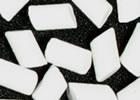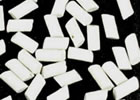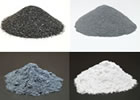Pigeon Blood Tumbling Rough
An easy-to-tumble rough for the beginner.
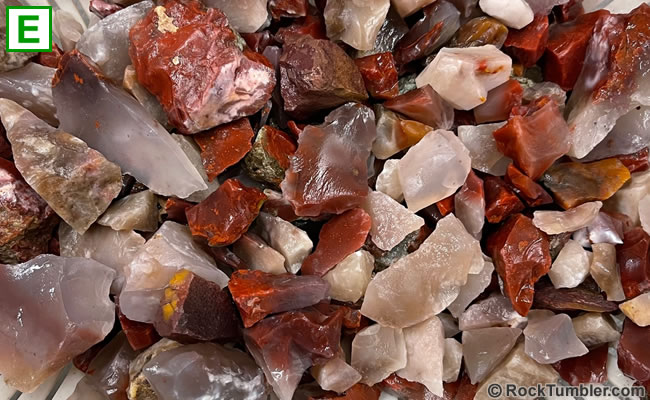
This photo shows two pounds of Pigeon Blood tumbling rough, scattered in a colander and sprayed with water to reveal its translucence and red to dark red color. The pieces of Pigeon Blood being sold here range in size between about 3/8 inch and 1 1/2 inches (measured across their maximum dimension). They range in composition from a white translucent chalcedony to a dark red jasper.
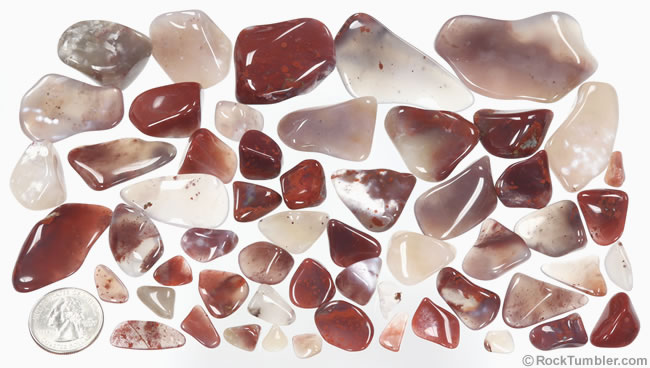
We polished a few pounds of Pigeon Blood in a Thumler's 3-pound rotary tumbler. Here are some of the stones that we liked. If you look closely at your tumbled stones, you can clearly see that some of this material is a foggy translucent chalcedony with a few tiny red inclusions that look like blood spatter. Other pieces are translucent chalcedony with many blood-colored inclusions. And, some pieces have so many inclusions that the material is opaque and can be called a "jasper".
Pigeon Blood Tumbling Rough
 ,
,  , and
, and  What do they mean?
What do they mean?
Size:
Mostly 3/8 inch to 1 1/2 inch pieces-- Highly recommended for beginners
-- Easy-to-polish
-- Small-size rough for small rotary tumblers
-- Named for its blood-red inclusions
-- Use our instructions for jasper, agate & chalcedony
What Is Pigeon Blood?
Pigeon Blood is an easy-to-polish tumbling rough intended for use in small rotary tumblers. It was mined from a deposit in Utah that yields material with the following characteristics (and all stages in between):
- some of the material is a foggy translucent chalcedony with a few red inclusions that look like "blood spatter"
- some of the material has many more red inclusions - but not enough to make the material opaque
- some of the material has so many red inclusions that it is opaque and deserves to be called a "jasper"
| Tumble this rock using our Instructions for Jasper, Agate, and Chalcedony. |
| Related: What Are Agate, Jasper and Chalcedony? |
Our Tumbling Tests

Please don't pour your rock tumbling waste water down a drain. It will harden in the drain and ruin your plumbing!
We followed the coarse grit tumbling with one week in medium grit (150/220 mesh), then one week in fine (500F) grit. It was then ready for polishing.
For the polishing step, we tumbled our Pigeon Blood into brightly polished stones with one week in TXP aluminum oxide polish. (Aluminum oxide is an inexpensive polish that we use in nearly 100% of our rotary and vibratory tumbling.)
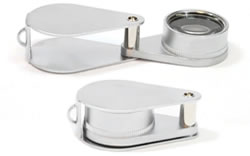 Folding Hand Lens
|
Checking Out the Details
After you polish a batch of Pigeon Blood, get a 10x hand lens (the name geologists use for a "magnifying glass") and examine several distinctly different stones under a bright light.
You should see that some of the stones contain a few fuzzy red inclusions (many of which are perfect spheres). When examining inclusions, first focus on the surface of the stone, and then look a little deeper - to see inclusions below the surface.
Begin with a stone that has just a few inclusions. If you look into that stone, you will probably see that some inclusions are tiny perfect spheres.
Once you figure out how to look beneath the surface, try examining a stone with a higher density of inclusions. Some of the larger inclusion aggregates will have a "mossy" appearance.
Finally, some stones are packed so full of red inclusions that light will not pass through the material. The definition of "jasper" is a chalcedony that is opaque. That is what you might have.
| Tumble this rock using our Instructions for Jasper, Agate, and Chalcedony. |
Pigeon Blood - Tumbling Properties | |
| Marketing Name: | Pigeon Blood |
| Classification: | Quartz >> Chalcedony (microcrystalline quartz) Most of the stones in your Pigeon Blood package will be a translucent chalcedony. Some stones will have so many red inclusions that they are opaque. Opaque chalcedony is the gemological definition of "jasper". |
| Composition: | Microcrystalline quartz (SiO2) |
| Mohs Hardness: | 6+ to 7 |
| Size: | Pieces of this rough range from about 3/8 inch up to 1 1/2 inches in size (measured across the maximum dimension). |
| Recommended Recipe: | We tumbled Pigeon Blood in a Thumler's A-R2 rotary tumbler with good results using our "Tumbling Instructions for Jasper, Agate, and Other Hard, Tenacious Materials". |
| Recommended Polish: | TXP aluminum oxide |
| Tips for Rock Tumbling Success: | (1) For nicely rounded stones, we tumble Pigeon Blood for two weeks in coarse (60/90) silicon carbide grit - with a grit change at the end of one week.
(2) Some people do a 30-minute burnishing tumble with grated Ivory bar soap after the polishing step. This often can improve the luster of your stones. See the burnish article for how you can determine if the burnishing step will be helpful. |
| * Tumbling properties are for the stones being sold here. Stones purchased from other vendors may require a different procedure. If your material was sold as "tumbling rough" you should ask the vendor for tumbling instructions. | |
Customers also bought...
Large Ceramic Media

Small Ceramic Media

Standard Grit Kit



